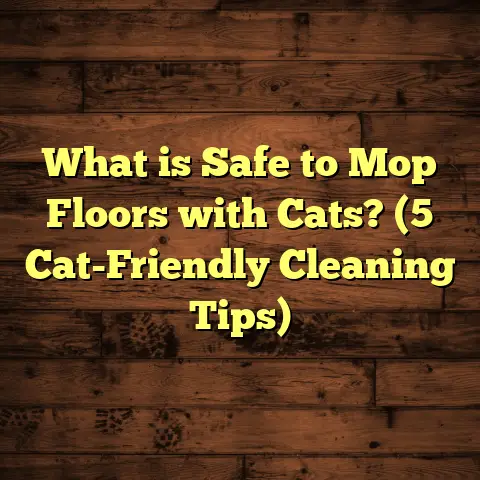What Is a Slip Resistant Floor? (5 Benefits for Safety & Design)
Have you ever suddenly lost your footing on a slick floor and almost fallen? Maybe it happened in your kitchen, bathroom, or even at work. It’s startling, right? I’ve been working in the flooring industry for many years, and I can tell you that slips and falls are one of the most common accidents people face daily. That’s why I’m a big fan of slip resistant floors—they can make a huge difference in safety without sacrificing style.
But what exactly makes a floor slip resistant? How do you choose one? And more importantly, what benefits does it bring beyond just preventing accidents?
Let me walk you through everything I’ve learned from hands-on experience, research, and working with countless customers. This will be a friendly chat about slip resistant floors—breaking down technical stuff into easy bits, sharing stories from projects I’ve done, and even diving into some surprising data.
What Is a Slip Resistant Floor?
At its core, a slip resistant floor is any flooring surface designed to provide better traction underfoot. That means when you step on it—especially if it’s wet or oily—you’re less likely to slip because the floor grips your shoe or foot more effectively.
Slip resistance depends mostly on the texture and material of the floor surface. Some floors have rough textures, grooves, or coatings that improve grip. Others use special finishes or embedded particles to increase friction.
How Is Slip Resistance Measured?
This is where it gets interesting. You might think “rough” automatically equals slip resistant, but it’s not that simple.
The industry measures slip resistance using something called the coefficient of friction (COF). It’s a ratio that compares the force needed to move an object across a surface to the force pressing down on it. In flooring:
- A higher COF means better grip.
- A lower COF means more slipperiness.
There are two types of COF tests relevant here:
- Static COF: Measures friction when you start moving.
- Dynamic COF: Measures friction while sliding.
For safe walking surfaces:
- A static COF of at least 0.6 is considered safe under dry conditions.
- For wet surfaces, a dynamic COF of 0.8 or higher is preferred.
Testing methods include:
- The pendulum test, which simulates a footstep with a swinging arm.
- The drag sled test, pulling a weighted sled across the floor.
- The incline plane test, where a person stands on an inclined surface until slipping occurs.
Each country or region may have slightly different standards, but these tests help manufacturers certify their flooring products.
My Personal Take on Slip Resistance
I remember early in my career, I installed polished marble in a client’s bathroom. It looked gorgeous but was slippery when wet. The client called me frustrated after a near fall incident. After that, I started recommending slip resistant finishes or alternative materials for wet areas.
That experience taught me: aesthetics are important but never at the cost of safety.
Why Slip Resistant Floors Are More Than Just “Anti-Slip”
You might think these floors are only necessary in places like hospitals or factories. Actually, slip resistant flooring is useful everywhere—from homes to commercial buildings to outdoor spaces.
Myths vs Facts
- Myth: Only elderly people need slip resistant floors. Fact: Anyone can slip, young or old. Spills, rain, dust—all create hazards.
- Myth: Slip resistant floors are ugly or industrial-looking. Fact: Today’s products come in a vast array of styles and finishes. You can have safety and style.
- Myth: Only wet areas need slip resistance. Fact: Even dry floors can be slippery if dusty or oily.
5 Major Benefits of Slip Resistant Floors for Safety and Design
Let me share the key reasons I always recommend slip resistant floors, backed by real stories and data.
1. Reduced Risk of Injury — The Safety Factor
This is the biggest reason anyone should consider slip resistant flooring. Slipping causes millions of injuries annually worldwide—everything from minor bruises to debilitating fractures.
Data Speaks
- The Centers for Disease Control (CDC) reports that falls cause over 3 million emergency visits yearly in the U.S.
- According to OSHA, slips and falls cost employers over $70 billion annually in lost productivity and medical expenses.
- A study at a senior living community showed installing slip resistant flooring reduced falls by 40% in six months.
I saw this first-hand when working with an assisted living facility. They replaced their smooth vinyl with textured slip resistant vinyl in hallways and bathrooms. The result? A noticeable drop in fall-related injuries and happier residents.
2. Boosted Confidence and Independence
Think about your parents or grandparents moving around their home. Slippery floors can make them hesitant or scared to walk freely.
Slip resistant floors add grip that helps them feel steadier on their feet. This often means more independence and less fear of falling.
A close friend recovering from knee surgery told me how much safer she felt once her bathroom floor was upgraded with slip resistant tiles. She could shower without assistance again—a small change with a huge impact on her quality of life.
3. Stylish Yet Practical Design Options
Safety doesn’t mean sacrificing looks anymore. The flooring industry has come a long way in offering products that balance aesthetics with function.
For example:
- Porcelain tiles with micro-textures that look like wood or stone.
- Vinyl planks with anti-slip coatings that mimic hardwood.
- Rubber flooring in vibrant colors for gyms or playrooms.
- Epoxy floors with embedded grit for industrial yet clean looks.
In one project for a boutique hotel lobby, we used patterned slip resistant tiles that guests loved for their beauty and feel underfoot.
4. Compliance with Safety Codes & Reduced Liability
Commercial spaces often face strict regulations about floor safety due to liability concerns.
Slip resistant floors help businesses meet these requirements easily. This minimizes legal risks and shows customers you care about their well-being.
A restaurant owner client nearly got fined because their kitchen floor was too slippery under inspection. We installed certified slip resistant tiles, which passed all tests first time and let them open without delays.
5. Long-Term Durability & Easy Maintenance
Slip resistant floors often have hard-wearing surfaces designed for heavy foot traffic and easy cleaning.
Materials like textured vinyl or rubber stand up well to stains, chemicals, and wear without losing grip properties.
I’ve seen gyms where rubber flooring lasted over 10 years with proper care—no slippery spots developing even after intense use.
Types of Slip Resistant Flooring: Pros and Cons
Let’s break down popular options so you can see which might suit your needs best.
| Material | Slip Resistance Level | Pros | Cons | Best Use Cases |
|---|---|---|---|---|
| Textured Vinyl | High | Affordable, easy install, water-resistant | Can wear over time | Hospitals, schools, kitchens |
| Rubber Flooring | Very High | Excellent grip, shock absorption | Limited styles | Gyms, playgrounds |
| Porcelain/Ceramic Tile (Textured) | Medium to High | Stylish, durable | Can be cold/hard | Bathrooms, commercial spaces |
| Carpet (Low Pile) | Medium | Soft landing, warm | Absorbs moisture | Bedrooms, offices |
| Epoxy Coatings with Grit | High | Durable, chemical-resistant | Slippery if worn down | Warehouses, garages |
| Wood with Anti-Slip Finish | Medium | Classic look | Requires maintenance | Residential living rooms |
My Experience Choosing Flooring Types
I once helped renovate a daycare center where safety was priority number one. We chose rubber flooring for play areas because it cushions falls and offers excellent grip for little feet running around.
In contrast, for an upscale spa project, porcelain tiles with fine textures gave the luxurious look clients wanted without compromising safety in wet areas.
Real-Life Case Studies
Case Study 1: Senior Living Facility Falls Reduced by 40%
A large senior care center installed slip resistant vinyl in all common areas and bathrooms after data showed increased fall risks on original smooth flooring.
Within six months:
- Fall-related injuries dropped by 40%.
- Residents reported feeling safer walking independently.
- Staff workload related to injury care decreased significantly.
This helped boost both resident satisfaction scores and operational efficiency.
Case Study 2: Restaurant Kitchen Safety Compliance
A popular city restaurant faced closure due to kitchen floor safety violations caused by slippery ceramic tiles.
Solution:
- Installed certified slip resistant porcelain tiles with textured finish.
- Passed all inspections immediately.
- Reduced staff slips by 60% within first three months.
- No downtime during installation thanks to quick curing materials.
The owner said this upgrade was “one of the best investments we made.”
How to Choose the Right Slip Resistant Floor for Your Space
When helping clients pick floors for safety and design, I consider several factors:
- Location & Usage
- Wet areas like bathrooms need higher slip resistance.
- High traffic zones require durable materials.
- Consider if children or elderly will use the space often.
- Budget Prices vary widely—from budget-friendly vinyl to premium textured tiles.
- Aesthetic Preferences Match flooring style with your interior design goals—for example, wood look vs modern tile patterns.
- Maintenance Expectations Some materials need special cleaners or coatings reapplied periodically.
- Compliance Needs Commercial spaces must meet local codes; residential may have different standards but safety remains key.
Installation Tips for Slip Resistant Floors
Getting the installation right ensures maximum safety benefits:
- Hire experienced contractors familiar with slip resistant products.
- Ensure subfloor is clean and level to avoid uneven surfaces.
- Follow manufacturer guidelines carefully—especially for adhesives or coatings.
- Consider adding entrance mats to reduce dirt and moisture tracked indoors.
- Test floors post-installation under various conditions (wet/dry).
Maintenance Advice: Keeping Your Floors Safe Over Time
Slip resistance can degrade if floors aren’t cared for properly:
- Clean regularly with non-waxing cleaners recommended by manufacturers.
- Avoid harsh chemicals that strip protective coatings.
- Fix chips or cracks immediately.
- Reapply anti-slip treatments if product suggests periodic renewal.
- Keep floors dry where possible—use mats at entrances and in wet zones.
Common Questions About Slip Resistant Flooring
Q: Will slip resistant floors feel rough or uncomfortable?
A: Not at all! Modern products balance grip with comfort and look smooth underfoot.
Q: Are slip resistant coatings permanent?
A: High-quality coatings last years but may need touch-ups depending on wear.
Q: Can I add anti-slip treatment to existing floors?
A: Yes, there are sprays and coatings designed for retrofitting but results vary by floor type.
Q: Do slip resistant floors cost more?
A: Sometimes slightly higher upfront but lower injury risks and maintenance costs make them worth it overall.
Final Thoughts From My Flooring Projects & Research
Slip resistant flooring is one of those smart investments that pays off in safety, comfort, style, and peace of mind over decades.
From helping families avoid accidents at home to assisting businesses meet regulations, I’ve seen how choosing the right floor keeps people safe every day.
If you’re thinking about upgrading your floors—don’t wait until after someone slips. Plan ahead with slip resistance in mind—it’s easier than you think and well worth it!
Have questions about your specific space or budget? Just ask—I’m happy to share advice tailored to your needs!
And if you want help estimating costs based on where you live, tools like FloorTally can provide detailed quotes factoring materials, labor rates, waste allowances, and design choices all in one place— making your planning smoother from start to finish.
Thank you for sticking with me through this deep talk about slip resistant floors. Stay safe out there!





